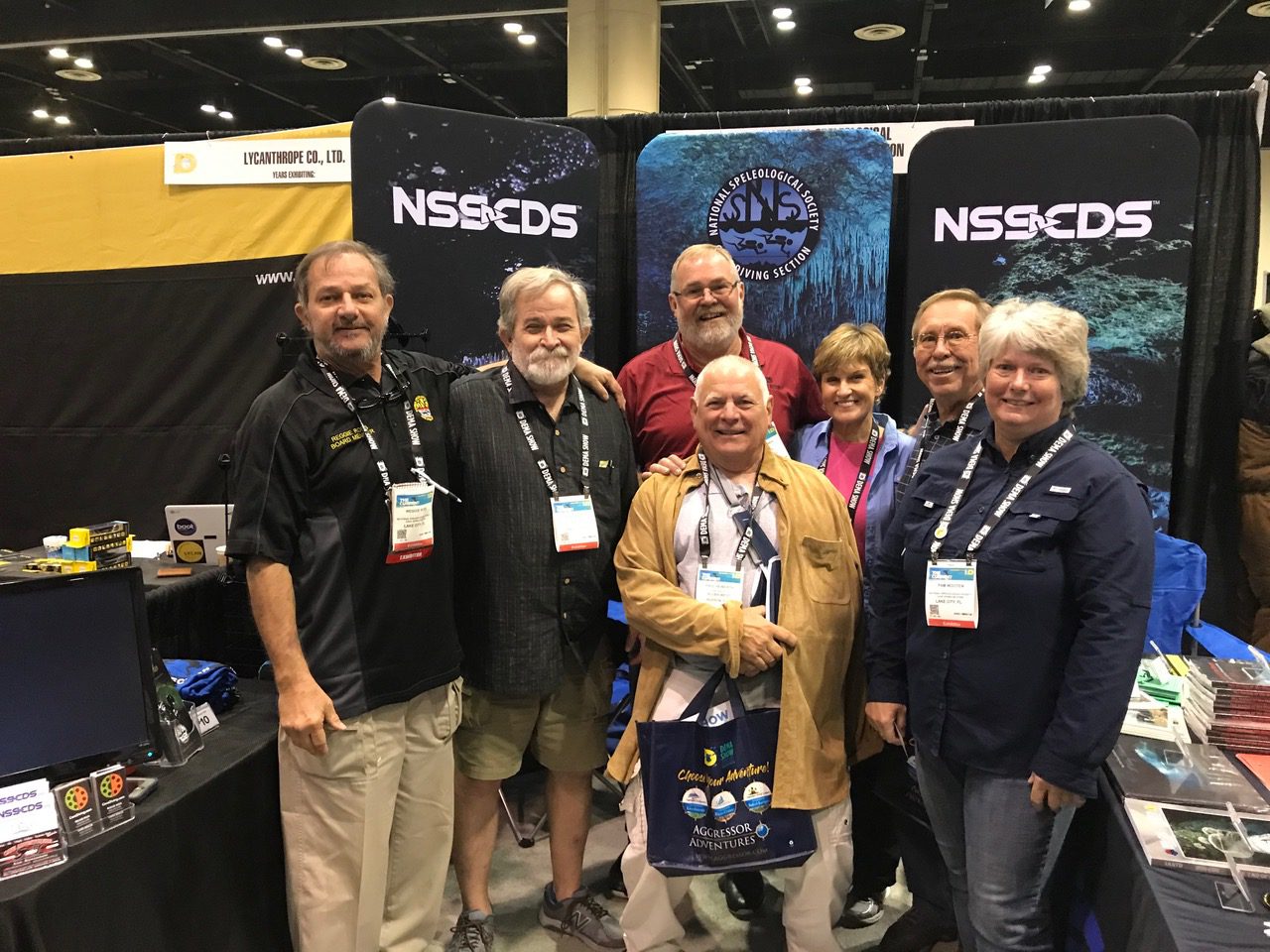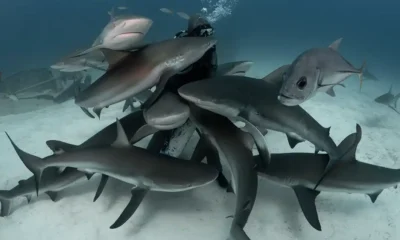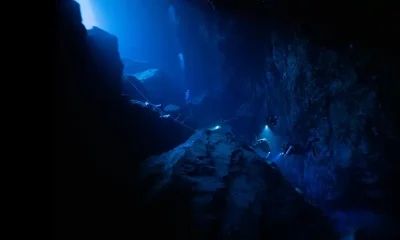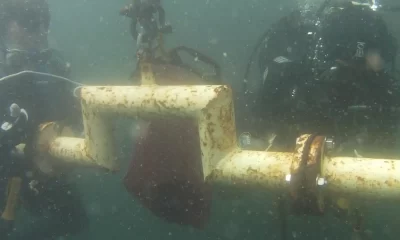News
The NSS-CDS Is Updating How It Teaches Cave Diving
Founded in 1973, the graybeards of Florida cave diving, the National Speleological Society-Cave Diving Division, are rethinking how to teach cave diving. Here CDS chair, Renee Power, along with CDS stalwart, Lamar Hires, explain the reasoning and results, with a bit of underground history thrown in.

By Reneé Power and Lamar Hires
Header photo L2R: Reggie Ross, Harry Averill, Lamar Hires, Paul Heinerth, Renee Power, Steve Forman, Pam Wooten at DEMA 2019. Photo courtesy of NSS-CDS.
“If you do not change direction, you may end up where you are heading.” Lao Tzu
Most will agree that change is not always easy. It is more comfortable to just keep the boat steady and for Heaven’s sake, don’t rock it! Often when there is directional change in an organization’s structure or processes, philosophies are challenged, egos get bruised, and we find ourselves clinging desperately to “the way we’ve always done it” because “if it ain’t broke, don’t fix it!” Maybe this object of change wasn’t broken ten or twenty years ago, but could it be now? Could we recognize it and are we open to self and process evolution?
The National Speleological Society-Cave Diving Section (NSS-CDS) cave diver training program has a long and storied history. Over the years, the cave training organization, which is one of the few training agencies in the world solely devoted to cave diving, has made changes in their teaching approach along the way that made sense at the time. However, when Reggie Ross (instructor # 286) was elected NSS-CDS Training Director in 2019, the Training Committee decided to take a step back and look at its entire training program.
The committee discovered that most of the programs and training levels were not a good fit for today’s cave and technical diver and, if we were honest, really needed an overhaul in philosophy and presentation. The four-level modular program that we used until the fall of 2019 was instituted many years ago and allowed divers to progress at a comfortable pace, gaining experience between levels. The program was based on North Florida cave diving as it was three decades ago when the springs had higher outflows and longer flood seasons. Sadly, the North Florida springs now have reduced flow that more mirror Mexico and other destinations.

The entire training program needed to be adjusted in order to accommodate newer styles of cave diving as well as other environmental considerations. It was decided to update the format and progression of the past three decades to provide more bottom time in the configuration that the student planned to dive in, versus simply have them progress from a single cylinder to a back mounted or side mounted doubles configuration.
Historically, the NSS-CDS Cavern Diver Course was the first step in overhead training and was conducted in a single tank or a double tank configuration with limited gas use. Cavern limits kept students on a single line and taught them to manage their reel, their lighting and their basic overhead diving skills. Over the years, it transitioned from a stand alone course for safe cavern diving to the gateway to a cave diving program.
The next level of cave training was the Intro-To-Cave Course that was again conducted in a single cylinder. The Basic Cave Course was the same course only it was conducted in a double tank configuration using limited gas. The limited gas usage rules limited penetration, to avoid decompression, especially the popular North Florida training caves. The course focused on perfecting buoyancy and trim, basic cave dive planning and confident execution of emergency skills and drills, as a prerequisite to advancing further.
The next two levels in the NSS-CDS cave training program were, Apprentice Cave and Full Cave with focus on progressively complex navigation, gas management, decompression strategies and dive planning. With a “temporary” Apprentice Cave rating, the student diver was expected to gain experience prior to enrolling in the Full Cave Course.
When dive computers and Enriched Air Nitrox came along in the 90s, it became obvious that divers would likely go further into the caves, ignoring the gas limitations set for their level of training. After all, what could go wrong by going into the cave “just a little bit more.”
Remember Y2K? This “Millennium Bug” was prophesied to negatively rock our world. Thankfully, the predictions were largely incorrect. However in the diving world, a limit-crushing cylinder configuration came out of the closet and, like it or not, went viral. Hello sidemount!
Initially, sidemount was a tool utilized by cave explorers to traverse much smaller passages that was simply not possible using traditional back mounted doubles. But then sidemount mutated from a useful exploration tool to a lifestyle choice, at least some of it due to back problems, and the consolidated weight of back mounted doubles.
Students at all levels wanted to train in this configuration. Fast forward to today: sidemount, backmount and rebreather divers all want to dive together, presenting new challenges for traditional training that had to be addressed.
Out With The Old; In With The New
The Cavern Course
Today, the Cavern Course is again an awareness and safety program. It is strictly a survival course utilizing restricted training limits to help the student develop awareness of overhead environment dangers, how to prevent problems and how to manage them should they occur. Students are taught finning techniques and gas management suitable for the cavern environment along with very basic guideline handling.
Arguably, the course is a critical step in a recreational diver’s mind shift as they learn more about trim and buoyancy while task loaded, and how to manage critical data such as depth, time, and gas supply. Equally important they will experience why these skills are important through discovery learning. This single cylinder course is no longer a prerequisite nor does it count toward further cave training.
The Cave Program
The new NSS-CDS Cave Program is now a two-step process; Apprentice Cave and Cave.
Apprentice Cave is the first step leading to full NSS-CDS Cave Diver certification. It takes the place of the old Cavern, Basic, and Intro-to-Cave Diver courses.
- The focus is primarily on limited penetration along the main line. It is also where students learn, and master critical emergency skills.
- Usable gas supply is limited putting a heavy emphasis on gas matching and dive planning.
- Provides students with the opportunity to gain limited experience and practice fundamental cave diving skills prior to completing the requirements for Cave Diver certification.

After spending time in the Apprentice Course training, the instructor may deem the student qualified and ready for an extension of limits. The new Apprentice Cave Diver “Statement of Understanding” form initiates this process. This is where the instructor specifies what the extended limits are, and the range the student must stay within. These extended limits may include gas use, distance, limited decompression and navigation.
The CDS Basics Orientation Course
A new prerequisite for enrolling in the Apprentice Cave is certification or proof of experience in the use of back mount or sidemount doubles, and demonstrated proficiency in buoyancy, trim, and the appropriate propulsion techniques needed for cave diving. If the student is unfamiliar to the instructor, the CDS Basics Orientation Course is used as a prep course that includes academics, dry-land and in-water exercises. Completion of this course allows entry into the Apprentice Cave course, but is not a certification. The best part is that this orientation course may be conducted in a swimming pool!
Cave
This is the second and final step toward an NSS-CDS full Cave Diver certification. Usable gas volume is increased, advanced navigational challenges are added and decompression strategies are discussed and executed. Dive planning is expanded to include multilevel dives and more elaborate gas planning. After completing a four to six day cave program, the divers are now trained and confident enough to plan and execute complex navigation cave dives.
All of the NSS-CDS Training Standards and Procedures are getting an overhaul section by section to include Special Programs, Specialty Courses and Leadership Standards. This is an extensive project taken on by the Training Committee. We expect this undertaking to take some time but we are off to a positive start.
And those aren’t the only changes! We also created:
- A beautiful new website that looks and works better.
- A brand new subdomain dedicated to the Training Program.
- Regular issues of Training Program News.
- Better branding with a stunning new logo that is instantly recognizable.
- A painless renewal process for instructors (yay!).
- Simplified forms and payment for student registration.
- International outreach.
Although Reggie Ross has left this earth, his vision lives on. [Ed.note: Reggie passed on December 24, 2019] Max Kuznetsov was elected as the new NSS-CDS Training Director. Max and his Training Committee, will undoubtedly continue to lead us boldly into an even better future.
End Note: The NSS-CDS training committee consists of Max Kuznetsov, Harry Averill, Chris Brock, Paul Heinerth, Lamar Hires, Ted McCoy, and Ken Sallot.
Dive Deeper:
Check out the History of NSS-CDS
The first issue of what is now Underwater Speleology, circa March 1974
Underwater Speleology May/June 1995 Vol 22 No. 3-Note articles on the “new” Apprentice Cave course by Lamar Hires, and a story on the Hogartian Method by Jarrod Jablonski who went on to become NSS-CDS Training Director before starting Global Underwater Explorers (1998).

Reneé Power conducts computerized tomography at a hospital in Florida and has over 30 years of professional experience. She has served on the Cambrian Foundation dive team since 1999 and has been involved with cave exploration and research diving in Mexico, Bermuda and Florida serving at times as the expedition Dive Safety Officer.
She is a cave and technical instructor with the NSS-CDS, TDI, and NAUI. Renee is a PADI Master Instructor and IDC Staff Instructor. She is currently the chair of the Board of Directors for the NSS-CDS and is a member of Karst Underwater Research. Reneé is the owner and founder of Dive By Design and mentors divers to develop skills in a safe and positive learning environment that facilitates growth through performance based progression.

Dive Rite CEO, Lamar Hires started his diving career in North Florida in 1979. Within his first five years of diving, Lamar had logged in excess of 1000 dives. In 1984, the year Dive Rite was established, Lamar earned his open water instructor rating as well as his cave diving instructor rating. He has explored and mapped a number of cave systems in North Florida and around the world. Lamar’s motivation to explore and challenge himself has led to the development of several Dive Rite products and influenced diving techniques, such as sidemount diving.
Lamar’s diving experience includes exploring a variety of cave systems around the world, wrecks of the Great Lakes and the oceans, the warm waters of the Caribbean, and the frigid waters of Antarctica. Along with exploration, Lamar has a passion for teaching and passing along his vast knowledge of diving. He actively teaches rebreather, sidemount, cave diving, and a variety of technical diving specialties. His involvement in the diving community has earned him numerous awards and recognitions.















































